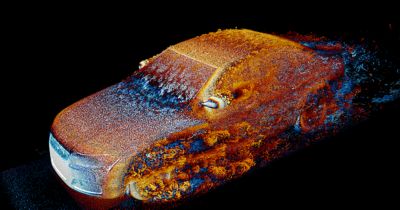Saunas have been proven to complement a healthy lifestyle. They have also been a cultural staple in several nations, especially in Finland, for hundreds, maybe even thousands, of years. Many believe that using saunas’ heat to increase circulation and promote relaxation is invaluable.
Imagine having the knowledge and tools to design and build your own personal sauna in your backyard. Corentin Macqueron made this dream a reality not once but three times by creating his own home saunas — most recently for his current home with assistance from Ansys simulation software.
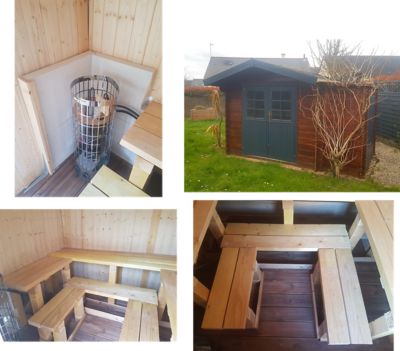
Corentin Macqueron’s home sauna in Trélazé in the Angers region of France
Macqueron has been a computational fluid dynamics (CFD) engineer at Orano, a French nuclear company that is determined to make nuclear power a part of the sustainable energy equation, for 16 years. Orano offers a wide range of services to customers, from mining, transportation, and nuclear decommissioning to waste management, nuclear medical treatments for cancer, and engineering services. Macqueron began using Ansys Fluent fluid simulation software during his internship. At Orano, he works on a small team focused on simulating safety scenarios at nuclear facilities.
“We are using Fluent simulation to make numerical simulations for the nuclear industry,” he says. “I’ve always loved Fluent software. We use it to simulate the many things that could happen in a facility.” In addition to safety, he is the technical referee for the artificial intelligence (AI) service at Orano. He is working to integrate the Ansys SimAI cloud-enabled generative AI platform into his work in AI.
Applying CFD for Maximum Customization
As an engineer with many years of experience in simulation and AI, he decided to use his knowledge and Ansys tools to help design his backyard sauna.
“I really like to do CFD for fun,” he says, “so I did this home project in my spare time. Also, I wanted to have some insight into the thermal flow inside a sauna so I could understand in detail how my sauna was going to work.”
A sauna typically comprises a small room that is heated using electric or wood-burning elements. To use it, the process sometimes involves pouring water over hot stones to create steam in the room (“löyly” in Finnish). The sauna is designed to maintain a temperature of about 176 to 212 degrees Fahrenheit (80 to 100 degrees Celsius) while allowing for proper airflow in and out.
Using an existing structure left by the previous homeowner, Macqueron began to plan his own sauna. He posed crucial questions on velocities, temperature distribution, and thermal leakage.
“What is, exactly, the balance between convection and radiation inside of a sauna?” he asked himself. “Is it heated by convection? Radiation? In detail, no one really knows, so I wanted to know if we could have some scientific answers to that.”
To create his home sauna, Macqueron generated a 3D CFD model using Fluent software. As he admits, using simulation in the design of a sauna is not necessary, but it was something that he wanted to explore to improve the design.
“I wanted to bring some new data, some new results, some new insight” to the sauna community, he says. He believes that a more detailed engineering approach can go into designing saunas for maximum customization and comfort.
The structure itself is a cabin that is 9 m³ and 2 m tall, featuring pine wood benches that Macqueron made by hand. It is heated with an electric stove that holds 75 kg of granite stone. On the walls surrounding the stove is cellular concrete for maximum insulation and protection. The sauna can hold up to six people and is “quite comfortable,” he says.
In the design process, Fluent software gave Macqueron the ability to study fluid flow from the stove to the walls, ceiling, floor, and vents to better understand the temperature distribution and heat flux levels in the sauna. In steady-state mode, he was able to study the temperature distribution and how it relates to the natural ventilation in the room. He created the mesh using Fluent software, particularly the Ansys Mosaic technology, with a meshing boundary resolution of 1/10 mm to 10 cm. Using smaller cells closer to the heat source enabled him to view in greater detail just what is happening in and around the stove.
“The Mosaic technology approach allows for a poly-hexcore-type mesh,” he says. “It’s extremely efficient from a numerical perspective, and on top of that it’s absolutely beautiful.”
“There are a lot of discussions about where the air inlet should be located and the location of the air outlet in order to maximize the temperature or to maximize the thermal homogeneity,” he says. Because hot air rises, this can lead to vertical stratification of heat layers. While some people in the sauna might like this, “some people don’t want to have a hot head and cold feet,” he says.
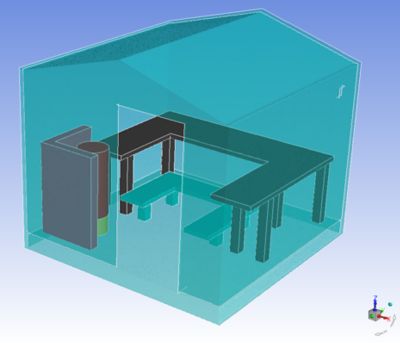
Interior sauna simulation
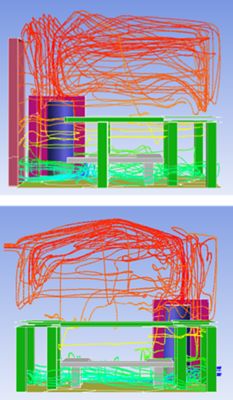
Fluid simulation in home sauna
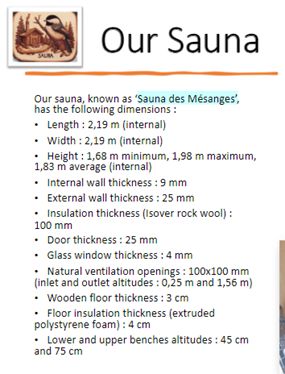
Specifications for the home sauna

Ansys Fluent fluid simulation software images of the heat flow inside Macqueron’s sauna and the resulting temperatures of the stove, benches, walls, floor, ceiling, and door
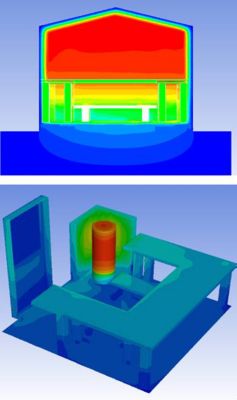
Heat dispersement in home sauna
By studying the ventilation rate in the environment, Macqueron was able to determine the best locations for the vents in his sauna, based on his preferences. His simulations ultimately uncovered unexpected findings. One was the discovery that the area of the ceiling above the stove was reemitting radiation.
“It is an interesting result,” Macqueron says. “It was not straightforward, and maybe people had not thought about this before. So of course the sauna is losing heat through conduction to the outside, but a lot of energy is reemitted through radiation inside because of the hot plume of gas impacting the ceiling. And of course the walls radiate toward people, who are ‘cold.’ But even with no one inside, the hot parts of the walls radiate toward the cooler parts of the walls, and it is very interesting to visualize. The ceiling in particular, which is strongly heated by the plume of hot air above the stove, radiates a large amount of energy downward, and I don’t think this has been quantified yet.”
“I also wanted to numerically validate a fundamental Finnish concept: the steam law (“first law of löyly”), which states that to enjoy even heat and an effective steam cloud, your feet should be a little bit higher than the stove stones, and you should be seated 45 cm higher, with 120 cm between the seat and the ceiling. My sauna is a bit lacking in height to fully comply with these rules. It works very well, but I wanted to know what it would be like with a bit more height. Thanks to Fluent software, I was able to test this hypothesis numerically, with a ‘what if’ type study. I didn't change anything except the ceiling height, and I raised the benches. For the same heating power, the temperatures felt at the benches are higher and clearly more even. The Finnish design rules are very well thought out.”
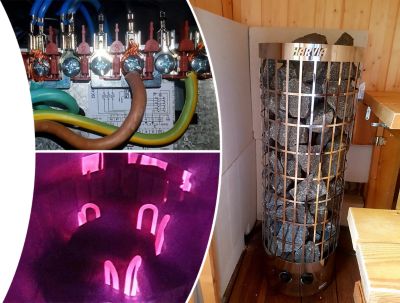
Home sauna stove
Another finding was that a stove can be treated like a porous homogenous material. This simplifies the process and is easier than detailing all the stones of the geometry while still showing reliable results for the stones and stove themselves. From an engineering perspective, this simplification works quite well. However, in his study, Macqueron explains that “a detailed approach with all stones and stone details is required to provide reliable results for these elements. Of course, we lose a bit of precision and slightly underestimate the wall temperature at the hottest point because it’s closest to the stove, but it’s much easier and faster to mesh and also much quicker to converge. We capture the essence of the thermo-aeraulic flow in the sauna very well, and from an engineering perspective it’s an excellent trade-off and an excellent value for money.”
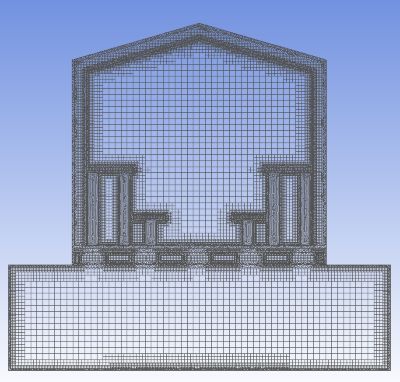
Fluent software was used to generate the mesh for the sauna.
Contributing to the Future of Saunas
After several years spent designing and building three home saunas, Macqueron says he is ready to “rest a little bit” and enjoy his growing family and sauna that he put so much time into. However, he is eager to share his work with others and has published his final study on ResearchGate for all to reference. In the future, he plans to bring further insight regarding stratification challenges, as well as adding the human body to the model to study heat fluxes and comfort. He will soon begin work with a Finnish architect to design new “exotic” saunas.
Macqueron has even generated his own free “Sauna Simulator” artificial neural network that is available to the public upon request. This complex sauna simulator can supply data, such as room temperature, at any given time, based on the size and power of the sauna, mass of the stones, mass of the stove, and thickness of the wood and insulation, all in real time. His public works on sauna design also include SaunaGPT, based on ChatGPT, which serves as an AI sauna expert, pulling information from his own database.
Macqueron’s passion for advancing the design of saunas is evident from his years of work. His findings can benefit others who are looking to explore the creation of a customizable sauna experience in their backyards. Macqueron hopes that sauna manufacturers will see the value that simulation can bring to every design aspect of a sauna.
Using Ansys products and his own curiosity and ingenuity, Macqueron has proven that even a time-honored cultural tradition can be advanced into the future through simulation.
Access a free trial of Fluent software.
Just for you. We have some additional resources you may enjoy.
“I really like to do CFD for fun, so I did this home project in my spare time. Also, I wanted to have some insight into the thermal flow inside a sauna so I could understand in detail how my sauna was going to work.”
— Corentin Macqueron, computational fluid dynamics (CFD) engineer, Orano














